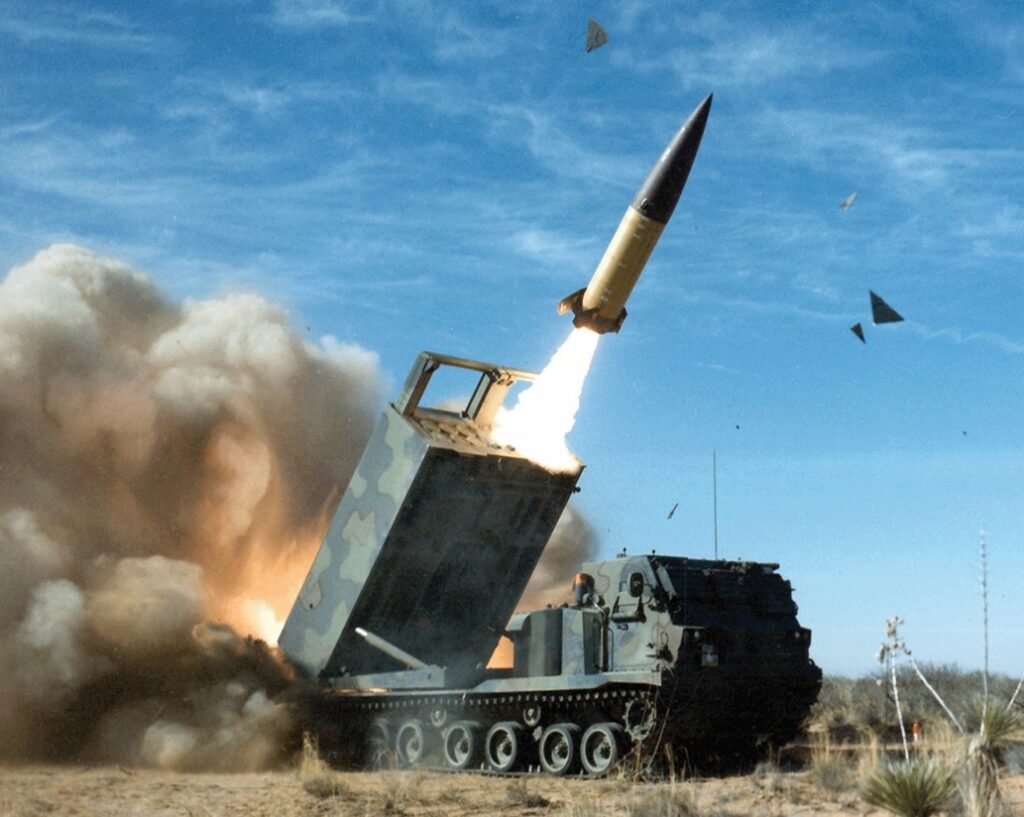
Army ATACMS missile launch.
“Outranged and outgunned” by Russian and Chinese missiles, the US Army wants a new long-range artillery rocket of its own. The nascent Long-Range Precision Fires program could do much more than replace the 25-year-old ATACMS missile, however. LRPF could become a linchpin of what the Army is calling Multi-Domain Battle, extending ground-based artillery’s reach not only to unprecedented ranges — hitting distant targets once reserved for airstrikes — but out to sea.
Why does the Army need to do this? Since 1991, when the Soviet Union fell and ATACMS entered service, the Army has largely neglected the artillery, so much so that one group of disgruntled officers called it a “dead branch walking.” Ground troops relied on the Air Force and Navy to dominate their own domains, prevent enemy airstrikes, and provide firepower on demand. But Russia, China, and even lesser powers like Iran have invested heavily in long-range, land-based anti-ship and anti-aircraft missiles to keep the US Air Force and Navy at bay. That means Army forces may have to bring their own in-house heavy firepower to the fight — not only to support its own units on land, but to help out the other services in the air and sea.
That’s where Multi-Domain Battle comes in. Against a high-tech foe with so-called Anti-Access/Area Denial defenses, where US fighters risk being shot down, the best way to take out an enemy airbase, missile battery or command post may be with a long-range land-based missile of one’s own. Likewise, when fighting an A2/AD adversary over a relatively narrow waterway — the Baltic and Black Seas in Europe, the East and South China Seas in Asia — the best way to destroy the enemy fleet may be from unsinkable missile bases on the land.

Army Tactical Missile System (ATACMS) launch
Admittedly, the initial iteration of Long-Range Precision Fires will probably be more limited. Currently, the Army intends to abide by the Intermediate Nuclear Forces treaty — despite Russia’s violations of it — and restrict LRPF’s range to under 500 kilometers (313 miles), which would still be a 67 percent increase over ATACMS. The Army is also not talking openly about an anti-ship LRPF specifically, although senior generals have called for ship-killing capability in general terms.
But LRPF is meant to be modular, open-architecture, and easy to upgrade. One of the two contractors on the program, Raytheon, told me that giving LRPF more than 500 km of range or an anti-ship seeker would be entirely doable.
“We’re going to provide a solution that allows them to very easily drop in alternate payloads, seekers, and other features,” said J.R. Smith, a former Air Force pilot who’s now Raytheon’s director of advanced warfare systems. “That’s one reason why you want to make your missile modular in its design, so that, for example you might drop in a different rocket motor down the road… There is a potential, as technology continues to advance, to come up with alternative rocket motors that will provide range in excess of 499 (km).”
Rival contractor Lockheed Martin — the incumbent on ATACMS — was more cagey when I asked this question. But VP for ground systems Scott Greene did note that “Lockheed Martin has a plethora of technology” that could be adapted for LRPF, such as its Long-Range Anti-Ship Missile (LRASM), if the Army wanted an land-based anti-ship solution.
The minimum requirement for LRPF is to perform as well as ATACMS: hit static targets on land up to 300 km away. Lockheed told me there’s plenty of potential to get more range out of ATACMS, let alone a new missile. You can also upgrading guidance. Static targets just require GPS and/or inertial navigation, but you need a radar or infrared seeker to find a moving target.
Once you’ve added that seeker for moving targets, though, you can use it against either ships or tanks, Smith said. In fact, even a small ship, like the 353-foot long Steregushchy corvette, is a vastly bigger target than a large tank, like the 35-foot-long T-14 Armata. Ships are also usually large metal objects that stick out from a flat expanse of water, while ground vehicles can hide among buildings, trees, or rocks.
Indeed, the Pentagon has repeatedly proven you can convert missiles made for other types of targets into anti-ship weapons. The Raytheon SM-6 missile defense interceptor gained anti-ship capability with no physical modifications, just a new software package, in one of the signal accomplishments of the newly created Strategic Capabilities Office. The software on the famed Tomahawk missile, designed to hit land targets, was essentially tricked into hitting moving ships.
So making LRPF capable of killing ships would be entirely in the realm of the possible. It would also be entirely in keeping with the Pentagon’s prioritization of naval warfare and its eagerness to wring new uses out of every weapon. Lockheed and Raytheon are currently on contract to study potential designs — which includes test detonations of live warheads — and expect 2017 awards of three-year contracts to build prototype rockets.
Army eyes TBI monitoring, wearable tech for soldiers in high-risk billets
“We are also looking at what additional personal protective equipment we can provide to our folks, especially instructors and others who are routinely exposed to blast pressure,” said Army Secretary Christine Wormuth.


























